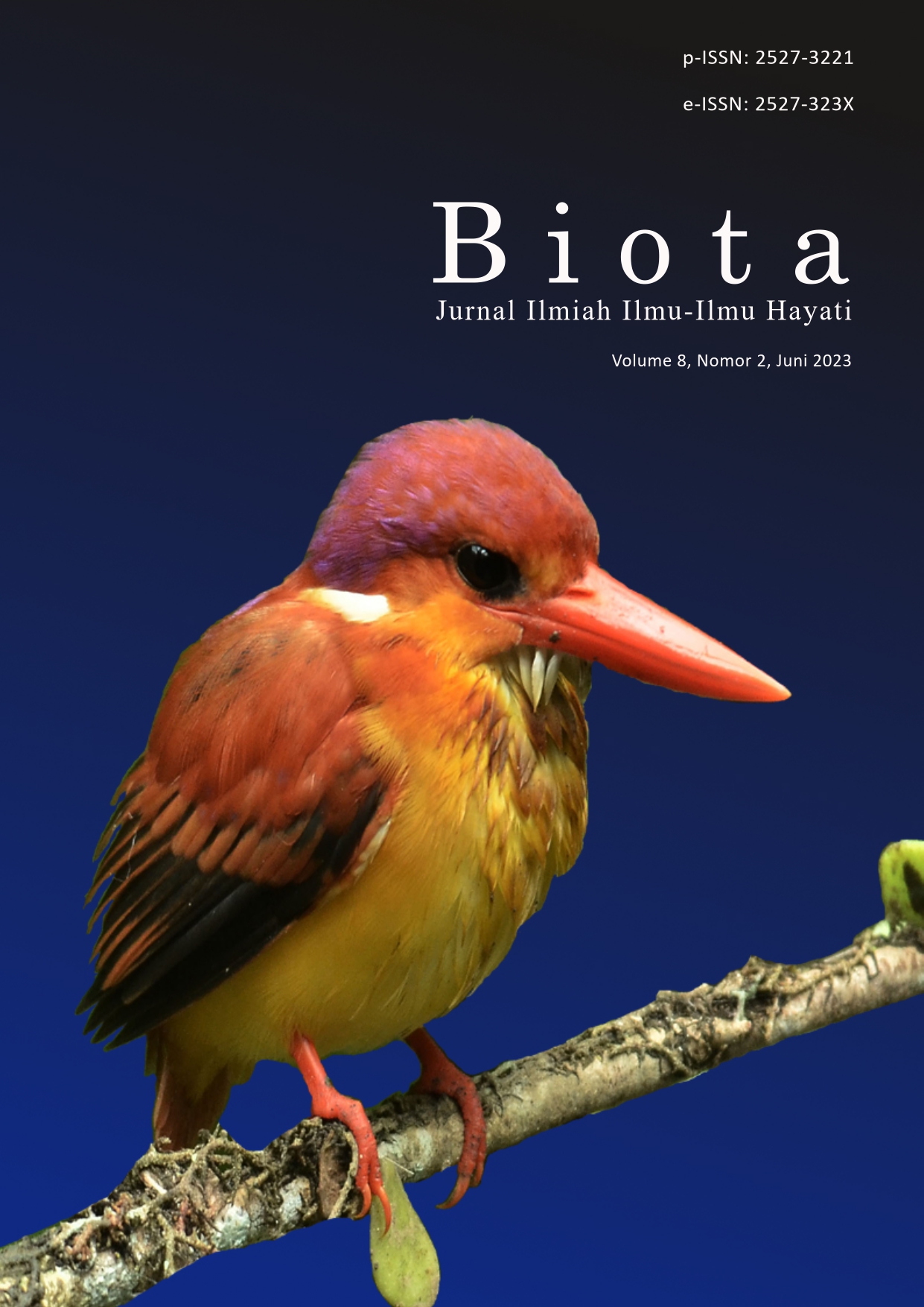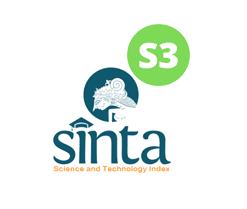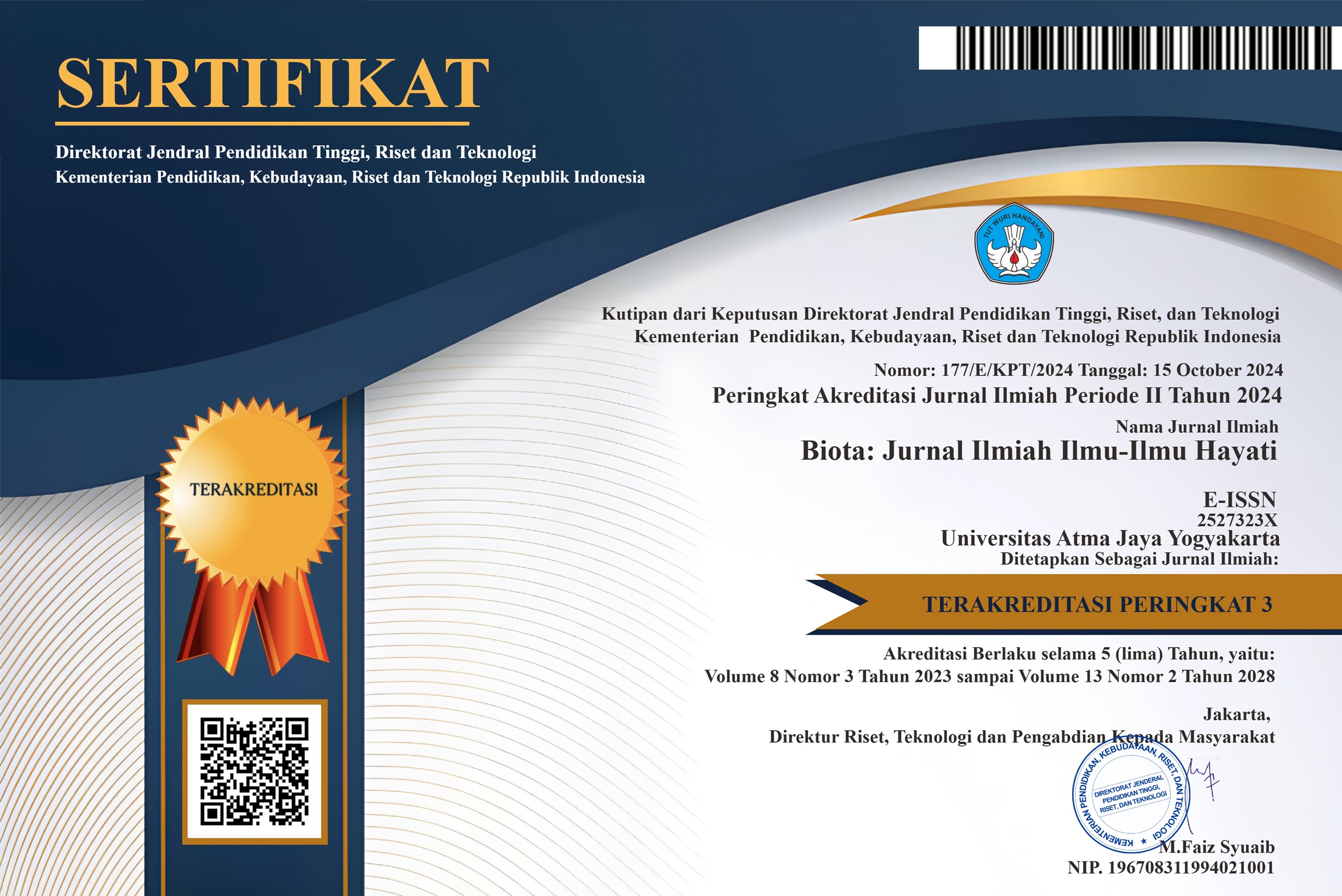Aktivitas Antimikroba Bakteri Asam Laktat yang Diisolasi dari Susu Sapi di Indonesia
DOI:
https://doi.org/10.24002/biota.v8i2.6554Keywords:
identifikasi molekuler, L. casei, L. paracasei, metode sumuran, supernatanAbstract
Bakteri asam laktat (BAL) diketahui memiliki potensi untuk menghambat pertumbuhan bakteri patogen. Pada penelitian ini, BAL yang diisolasi dari susu sapi di Indonesia diidentifikasi melalui pengamatan morfologi dan analisis molekuler. Pengamatan morfologi meliputi pewarnaan Gram dan endospora. Selanjutnya, identifikasi molekuler dilakukan dengan ekstraksi DNA, amplifikasi gen 16S rRNA menggunakan primer universal, sekuensing dan analisis BLAST. Uji aktivitas antibakteri dari cell free supernatant (CFS) yang dihasilkan isolat dilakukan dengan metode sumuran. Selain itu, dilakukan juga evaluasi terkait pengaruh suhu dan pH terhadap aktivitas antibakteri dari CFS. Berdasarkan pengamatan morfologi, isolat merupakan bakteri berbantuk batang, Gram positif, tidak menghasilkan endospora, dan tidak termasuk bakteri acid-fast. Hasil analisis 16S rRNA menunjukkan bahwa isolat memiliki kekerabatan yang erat dengan L. paracasei strain L1 (100%) dan L. casei strain WX121 (99,84%). Uji aktivitas antibakteri menunjukkan bahwa isolat mampu menghambat pertumbuhan E. coli dan S. aureus. Aktivitas penghambatan tersebut dipengaruhi oleh pH, tetapi tidak oleh suhu. Aktivitas penghambatan terbaik ditunjukkan oleh CFS dengan pH yang sangat rendah (pH 3). Suhu tidak mempengaruhi aktivitas antibakteri karena senyawa antibakteri yang dihasilkan isolat kemungkinan besar tahan terhadap panas.
References
Arena, M. P., Silvain, A., Normanno, G., Grieco, F., Drider, D., Spano, G. & Fiocco, D. (2016). Use of Lactobacillus plantarum strains as a bio-control strategy against food-borne pathogenic microorganisms. Frontiers in Microbiology 7: 1-10.
Bratcher, D. (2018). Other gram-positive bacilli. Principles and Practice of Pediatric Infectious Disease 4: 786-790.
Cappuccino, J. G. &Welsh, C. (2019). Microbiology: a laboratory manual. Pearson. New York.
Centers for Disease Control and Prevention (CDC). (2018). Staphylococcal (Staph) Food Poisoning, Retrieved August 20, 2022, from https://www.cdc.gov/foodsafety/diseases/staphylococcal.html.
Colombo, M., Castilho, N. P., Todorov, S. D. & Nero, L. A. (2018). Beneficial properties of lactic acid bacteria naturally present in dairy production. BMC Microbiology 18: 219.
Febriana, M. H., Purwijantiningsih E. & Yuda, P. (2021). Identifikasi dan uji aktivitas antimikrobia bakteri asam laktat dari fermentasi singkong (Gatot) terhadap Bacillus cereus dan Aspergillus flavus. Biota: Jurnal Ilmiah Ilmu-Ilmu Hayati 6(1): 15-24.
Gupta, R., Jeevaratnam, K. & Fatima, A. (2018). Lactic acid bacteria: probiotic characteristic, selection criteria, and its role in human health (a review). Journal of Emerging Technologies and Innovative Research 5(10): 411-424.
Hu, C. H., Ren, L. Q., Zhou, Y. & Ye, B. C. (2019). Characterization of antimicrobial activity of three Lactobacillus plantarum strains isolated from Chinese traditional dairy food. Food Science Nutrititon 7: 1997– 2005.
Huang, C. H., Li, S.W., Huang, L. & Watanabe, K. (2018). Identification and classification for the Lactobacillus casei Group. Frontiers in Microbiology 9: 1974.
Ibrahim, S. A., Ayivi, R. D., Zimmerman, T., Siddiqui, S. A., Altemimi, A. B., Fidan, H., Esatbeyoglu, T., Bakhshayesh, R. V. (2021). Lactic acid bacteria as antimicrobial agents: Food safety and microbial food spoilage prevention. Foods 10(12): 3131.
Ismail, Y. S., Yulvizar, C. & Mazhitov, B. (2018). Characterization of lactic acid bacteria from local cow´s milk kefir. IOP Conference Series: Earth and Environmental Science 130: 012019.
Ma, J., Yu, W., Han, X., Shao, H. & Liu, Y. (2020). Characterization and production optimization of a broad-spectrum bacteriocin produced by Lactobacillus casei KLDS 1.0338 and its application in soybean milk biopreservation. International Journal of Food Properties 23(1): 677–692.
Madigan, M. T., Bender, K. S., Bucklet, D. H., Sattley, W. M. & Stahl, D. A. (2022). Brock Biology of Microorganisms 16th Edition. Pearson. New York.
Meng, F., Zhao, H., Zhang, C., Lu, F., Bie, X., & Lu, Z. (2016). Expression of a novel bacteriocin—the plantaricin Pln1—in Escherichia coli and its functional analysis. Protein Expression and Purification 119: 85-93.
Mozzi, F. (2016). Lactic acid bacteria. In B. Caballero, P. M. Finglas & F. Toldra (Ed.), Encyclopedia of Food and Health. Elsevier. Amsterdam.
Mulaw, G., Tessema, T. S., Muleta, D. & Tesfaye, A. (2019). In vitro evaluation of probiotic properties of lactic acid bacteria isolated from some traditionally fermented Ethiopian food products. International Journal of Microbiology 2019: 1–11.
Noroozi, E., Mojgani, N., Motevaseli, E., Modarressi, M. H. & Tebianian, M. (2019). Physico-chemical and cytotoxic analysis of a novel large molecular weight bacteriocin produced by Lactobacillus casei TA0021. Iranian Journal of Microbiology 11(5): 397–405.
Rafieian-Kopaei, M., Karami, S., Roayaei, M., Hamzavi, H., Bahmani, M., Hassanzad-Azar, H. & Leila, M. (2017). Isolation and identification of probiotic Lactobacillus from local dairy and evaluating their antagonistic effect on pathogens. International Journal of Pharmaceutical Investigation 7(3): 137.
Ren, D., Zhu, J., Gong, S., Liu, H. & Yu, H. (2018). Antimicrobial characteristics of lactic acid bacteria isolated from homemade fermented foods. Biomed Research International 2018: 1-9.
Rizkinata, D., Andrian, D., Tan, S. R., Jap, L. & Tan, T. J. (2018). Isolation of Streptococcus thermophilus and Lactobacillus delbrueckii as starter culture candidate originated from Indonesian cow’s milk. Microbiology and Biotechnology Letters 46(3): 201-209.
Robinson, R. C. (2019). Structures and metabolic properties of bovine milk oligosaccharides and their potential in the development of novel therapeutics. Frontiers in Nutrition 6: 50.
World Health Organization. (2018). Diarrheal disease, Retrieved August 20, 2022, from https://www.who.int/en/news-room/fact-sheets/detail/diarrhoeal-disease.
Downloads
Published
How to Cite
Issue
Section
License
Copyright (c) 2023 Marcelia Sugata, Michell Suphandi, Tjie Jan Tan

This work is licensed under a Creative Commons Attribution-NonCommercial 4.0 International License.
Authors who publish with Biota : Jurnal Ilmiah Ilmu-Ilmu Hayati agree to the following terms:
- Authors retain copyright and grant the Biota : Jurnal Ilmiah Ilmu-Ilmu Hayati right of first publication. Licensed under a Creative Commons Attribution-NonCommercial 4.0 International License that allows others to share the work with an acknowledgment of the work's authorship and initial publication in this journal.
- Authors are able to enter into separate, additional contractual arrangements for the non-exclusive distribution of the journal's published version of the work (e.g., post it to an institutional repository or publish it in a book), with an acknowledgment of its initial publication in Biota : Jurnal Ilmiah Ilmu-Ilmu Hayati, and as long as Author is not used for commercial purposes.













